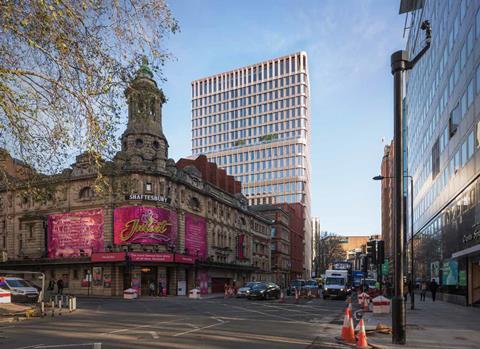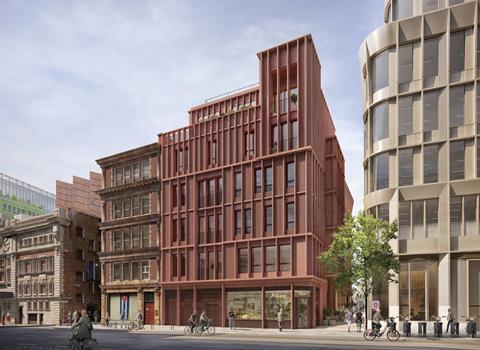Local architect to present grounds to overturn decision to approve 19-storey scheme in September

A proposed judicial review of the decision to approve DSDHA’s controversial plans for a 19-storey office tower in Bloomsbury has moved a step closer.
The High Court has allowed architect and veteran campaigner James Monahan to present grounds for the judicial review in an oral appeal on 10 September.
Monahan, of local practice Monahan Blythen Hopkins Architects, announced his plans for the judicial review in May.
He is arguing that Camden council has failed in its duty to protect heritage assets in approving the 74m-high tower on Museum Street, a historic part of Bloomsbury characterised by its Georgian terraces.
> Also read: Camden council to ‘robustly defend’ its decision on DSDHA’s Bloomsbury tower amid High Court challenge
The mixed-use scheme would replace the 1960s Selkirk House, a 17-storey former Travelodge hotel, with 44 homes and 22,650 sq m of office space. It would also include three six-storey buildings and one five-storey block containing housing and retail space.
The scheme for client BC Partners was signed off in November last year despite objections from Historic England, the Georgian Group, Save Britain’s Heritage and the London School of Economics.
More than 500 letters objecting to the planning application were also sent in by locals, including film-maker Mike Leigh and Victorian Society president Griff Rhys Jones.
The approval could be overturned if the High Court decides to proceed with the judicial review and rules in favour of Monahan’s case.
Monahan said Camden had not adhered to key requirements in national planning policies, the London plan and the borough’s own local planning policies in its decision to green light the application.
> Also read: Architect launches judicial review of DSDHA’s Bloomsbury tower plans
He said: “The decision to grant permission for a monstrous speculative office tower in Museum Street is one of the worst examples of a fawning attitude by the planners towards developers,” he said.
He added: “Senior Camden politicians give every indication that they do not care, and are far too busy eyeing up parliamentary seats, and senior planners just move on to pastures new and leave their mistakes behind.

“It all sounds like a very familiar story but this time Camden council’s planning committee and planning officers are being held to account. I have asked the High Court to review the lawfulness of Camden’s decision. This means that Camden will have to justify their actions.”
The judicial review is the latest bid launched by Monahan, who was part of a campaign to stop plans to redevelop parts of Covent Garden in the 1970s and 1980s.
Prior to last year’s decision to approve the scheme, Monahan proposed an alternative approach for the site which would see the existing Selkirk House refurbished and neighbouring buildings restored, which was not taken into consideration by the council.
The approved scheme is the third incarnation of the proposals, following earlier plans by DSDHA for a 21-storey tower on the site which were revised.
Historic England said the latest plans would still exacerbate the “visual discordance” caused by the existing building in views of the nearby historic buildings due to the proposed tower’s height and bulk.
Save Britain’s Heritage objected to the proposals because of the impact of the tower element, which is 20m higher than the existing tower, and also what it described as the scheme’s “substantially harmful and disproportionate” carbon cost.
















No comments yet